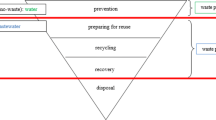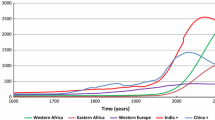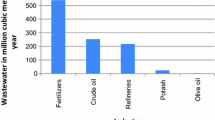Abstract
Global water resources are constantly flowing in the process of industrial trade, and changes in water resource production and consumption demand not only affect the total consumption and flow pattern of water resources but also the stable development of the economic system. How to achieve the goals of water conservation and the spatial balance of water resources while promoting social and economic stability and sustainable development has become an important prerequisite for the coordination and sustainable development of water resources and economic systems. Therefore, this paper starts with the industrial correlation effect of the downstream consumption side of the industrial linkage path, and uses the multi-regional input–output model, power-of-pull approach and industrial correlation effect model to deeply analyze the important path of the coordinated and sustainable development of China's water resources and economic system. The results show that: The relevant sectors of industry and service always have a stable and low pull index on the water consumption end, which had a small pulling effect on the water production end. Moreover, the flow of the industrial virtual water trade linkage path did not increase when total economic output value increased, making it an important development industry for the coordinated development of water resources and economic systems. Additionally, comparing the virtual water flow and flow direction of the industrial linkage path with the industry’s total economic and trade output value, it is found that the unreasonable industrial pulling effect and pushing effect have become one of the important obstacles affecting the spatial balance of water resources and coordinated economic development of China. Therefore, the regulation of virtual water trade pattern can not only be judged from the flow of the link path, but also need to combine the different correlation effects in the industrial link path to promote the coordinated and sustainable development of water resources and economic system more reasonably.





Similar content being viewed by others
Availability of Data and Materials
All data used are identified as sources in the text.
Reference:s
An TL, Wang LZ, Gao XR et al (2020) Simulation of the virtual water flow pattern associated with inter provincial grain trade and its impact on water resources stress in China. J Clean Prod 288(1):125670. https://doi.org/10.1016/j.jclepro.2020.125670
Cai R, Hu MT, Guo HT et al (2020) Optimization of domestic inter-regional virtual water trade of agriculture products in China. IOP Conf Ser Earth Environ Sci 446:052020. https://doi.org/10.1088/1755-1315/446/5/052020
Chao Z, Anadon LD (2014) A multi-regional input–output analysis of domestic virtual water trade and provincial water footprint in China. Ecol Econ 100(4):159–172. https://doi.org/10.1016/j.ecolecon.2014.02.006
China Water Resources Bulletin (2002/2007/2012/2017) Ministry of Water Resources of the People's Republic of China. China Water&Power Press
Chouchane H, Krol MS, Hoekstra AY (2017) Virtual water trade patterns in relation to environmental and socio-economic factors: a case study for Tunisia. Sci Total Environ 613–614:287–297. https://doi.org/10.1016/j.scitotenv.2017.09.032
Chen WM, Kang JN, Han MS (2021) Global environmental inequality: Evidence from embodied land and virtual water trade. Sci Total Environ 783(1):146992. https://doi.org/10.1016/j.scitotenv.2021.146992
Deng GY, Wang L, Xu XY (2018) Linkage effect of virtual water trade in China’s industrial products—based on generalized hypothetical extraction method. Ecol Ind 93:1302–1310. https://doi.org/10.1016/j.ecolind.2018.06.019
Delpasand M, Bozorg-Haddad O, Loáiciga HA (2020) Integrated virtual water trade management considering self-sufficient production of strategic agricultural and industrial products. Sci Total Environ 743:140797. https://doi.org/10.1016/j.scitotenv.2020.140797
Deng GY, Lu FY, Wu LP et al (2021) Social network analysis of virtual water trade among major countries in the world. Sci Total Environ 753:142043. https://doi.org/10.1016/j.scitotenv.2020.142043
Distefano T, Riccaboni M, Marin G (2014) Global virtual water trade: Integrating structural decomposition analysis with network theory
El-Gafy I, Apul D (2021) Expanding the dynamic modeling of water-food-energy nexus to include environmental, economic, and social aspects based on life cycle assessment thinking. Water Resour Manag 35:4349–4362. https://doi.org/10.1007/s11269-021-02951-y
Exiobase, 2002/2007/2012/2017. https://www.exiobase.eu/
Luo J (2013) Which industries to bail out first in economic recession? Ranking US industrial sectors by the power-of-pull. Econ Syst Res 25(2):157–169. https://doi.org/10.2139/ssrn.1430162
Li H, Li K, Liang YH et al (2021) Uncovering the structure of virtual multi-regional grey water network in China. Resour Conserv Recycl 172:105668. https://doi.org/10.1016/J.RESCONREC.2021.105668
Mao XF, Yang ZF (2012) Ecological network analysis for virtual water trade system: A case study for the Baiyangdian Basin in Northern China. Eco Inform 10:17–24. https://doi.org/10.1016/j.ecoinf.2011.05.006
Multi-regional Input-output Table of China (2002/2007/2012) National Bureau of China Statistics of the People’s Republic of China. China Statistics Press
Najafi Alamdarlo H, Riyahi F, Vakilpoor MH (2018) Wheat self-sufficiency, water restriction and virtual water trade in Iran. Netw Spat Econ 19:503–520. https://doi.org/10.1007/s11067-018-9383-4
Nishad SN, Kumar N (2022) Virtual water trade and its implications on water sustainability. Water Supply 22(2):1704–1705. https://doi.org/10.2166/WS.2021.322
Pisa N, Viviers W, Rossouw R (2015) Identifying industrial clusters for regional economic diversification: The case of South Africa’s North West province. Int Bus Econ Res J (IBER) 14(3):501–524. https://doi.org/10.19030/iber.v14i3.9212
Samadi-Foroushani M, Keyhanpour MJ, Musavi-Jahromi SH et al (2022) Integrated water resources management based on water governance and water-food-energy nexus through system dynamics and social network analyzing approaches. Water Resour Manag 36:6093–6113. https://doi.org/10.1007/s11269-022-03343-6
Seeley JR (1949) The net of reciprocal influence. a problem in treating sociometric data. Can J Exp Psychol 3:234. https://doi.org/10.1037/h0084096
Selim KS, Abdalbaki SM (2019) On the relationship between virtual water network and crops intra-trade among Nile basin countries. Water Policy 21(3):481–495. https://doi.org/10.2166/wp.2019.074
Sun CZ, Zheng JW (2020) Analysis of China’s water resources spatial transfer network based on MRIO and SNA. Water Resour Protect 36(01):9–17. https://doi.org/10.3880/j.issn.1004-6933.2020.01.002
Sun CZ, Zheng JW (2021) Structural path analysis of water resources consumption in China based on input-output table. Prog Geogr 40(3):370–381. https://doi.org/10.18306/dlkxjz.2021.03.002
The China Meteorological Data Service Center. http://data.cma.cn/
Wang SG, Cao T, Chen B (2021) Identifying critical sectors and supply chain paths for virtual water and energy-related water trade in China. Appl Energy 299:117294. https://doi.org/10.1016/j.apenergy.2021.117294
Wang JR, Konar M, Dalin C et al (2022) Economic and virtual water multilayer networks in China. J Clean Prod 381:135041. https://doi.org/10.1016/J.JCLEPRO.2022.135041
Wang HZ, Yang X, Hou HM et al (2023) Temporal dynamics, driving factor and mutual relationship analysis for the holistic virtual water trade network in China (2002–2017). Environ Impact Assess Rev 101:107127. https://doi.org/10.1016/j.eiar.2023.107127
Wang Z, Wei LY, Niu BB et al (2017) Controlling embedded carbon emissions of sectors along the supply chains: a perspective of the power-of-pull approach. Appl Energy 206:1544–1551. https://doi.org/10.1016/j.apenergy.2017.09.108
Wen W, Wang Q (2019) Identification of key sectors and key provinces at the view of CO2 reduction and economic growth in China: Linkage analyses based on the MRIO model. Ecol Ind 96:1–15. https://doi.org/10.1016/j.ecolind.2018.08.036
Wei KX, Ma C, Xia J et al (2022) The impacts of China’s crops trade on virtual water flow and water use sustainability of the “Belt and Road.” J Environ Manag 323:116156–116156. https://doi.org/10.1016/j.jenvman.2022.116156
Wu LX, Huang K, Ren YY et al (2022) Toward a better understanding of virtual water trade: Comparing the volumetric and impact-oriented virtual water transfers in China. Resour Conserv Recycl 186:106573. https://doi.org/10.1016/j.resconrec.2022.106573
Xu ZW, Yao LM, Zhang Q et al (2020) Inequality of water allocation and policy response considering virtual water trade: A case study of Lanzhou city, China. J Clean Product 269(4):122326. https://doi.org/10.1016/j.jclepro.2020.122326
Yan D, Jia ZW, Xue J et al (2018) Inter-regional coordination to improve equality in the agricultural virtual water trade. Sustainability 10(12):1–17. https://doi.org/10.3390/su10124561
Yang B, Qing GP, Yang H (2022) Analysis of CO2 emission accounting of China from the perspective of industrial linkage. Stud Sci Sci 40(11):1–18. https://doi.org/10.16192/j.cnki.1003-2053.20220921.001
Ye QL, Li Y, Zhuo L et al (2018) Optimal allocation of physical water resources integrated with virtual water trade in water scarce regions: A case study for Beijing, China. Water Res 129:264–276. https://doi.org/10.1016/j.watres.2017.11.036
Zhan MC, Chen GQ (2013) Virtual water accounting for the globalized world economy: National water footprint and international virtual water trade. Ecol Ind 28:142–149. https://doi.org/10.1016/j.ecolind.2012.07.024
Zhao Y, He GH, Wang JH et al (2020) Water stress assessment integrated with virtual water trade and physical transfer water: A case study of Beijing. China. Sci Total Environ 708:134578. https://doi.org/10.1016/j.scitotenv.2019.134578
Zhang F, Jin G, Liu G (2021) Evaluation of virtual water trade in the Yellow River Delta, China. Sci Total Environ 784:147285. https://doi.org/10.1016/j.scitotenv.2021.147285
Zhao ZQ, Gu JK, Wang JH (2022) Analysis on the correlation effect and spread effect of equipment manufacturing industry based on input-output. J ZhongYuan Univ Technol 33(03):63–72. https://doi.org/10.3969/j.issn.1671-6906.2022.03.010
Zheng JW, Sun CZ (2023) China’s water footprint flow pattern based on the MRIO and ESTDA models. China Popul Resour Environ 33(4):172–183. https://doi.org/10.12062/cpre.20221039
Acknowledgements
The authors would like to thank the interview participants that have provided valuable reflection.
Funding
This work was supported by the National Key Social Science Fund Project of China (19AJY010).
Author information
Authors and Affiliations
Contributions
All authors contributed to the study conception and design. Paper search and selection, data collection, analysis and visualisation were performed by J W Zheng. The first draft of the manuscript was written by J W Zheng. C Z Sun commented, revised, and edited on previous versions of the manuscript. All authors read and approved the final manuscript.
Corresponding author
Ethics declarations
Ethical Approval
The authors undertake that this article has not been published in any other journal and that no plagiarism has occurred.
Consent to Participate
All the authors have given explicit consent to participate in the manuscript.
Consent to Publish
All the authors have given explicit consent to publish this manuscript.
Competing Interests
There is no competing interest in regard to the study.
Additional information
Publisher's Note
Springer Nature remains neutral with regard to jurisdictional claims in published maps and institutional affiliations.
Supplementary Information
Below is the link to the electronic supplementary material.
Rights and permissions
Springer Nature or its licensor (e.g. a society or other partner) holds exclusive rights to this article under a publishing agreement with the author(s) or other rightsholder(s); author self-archiving of the accepted manuscript version of this article is solely governed by the terms of such publishing agreement and applicable law.
About this article
Cite this article
Zheng, J., Sun, C. The Influence of Industrial Pulling Effect on the Coordinated Development of China’s Water Resources and Economic System. Water Resour Manage 37, 5307–5323 (2023). https://doi.org/10.1007/s11269-023-03607-9
Received:
Accepted:
Published:
Issue Date:
DOI: https://doi.org/10.1007/s11269-023-03607-9




